
5 minute read
Academics
dysseyOAcademics
How Students Learn
SEEN AND HEARD IN ENGLISH CLASS
New themes abound in today’s English classroom where students enact sword fights, record video essays, and build board games. Traditional novels persist alongside more diverse readings and broader cultural applications, and written essays often complement a multifaceted project. Teachers incorporate technology at varying degrees, but all put a heavy emphasis on student input and engagement.
“Education has changed,” said Robert Hutchison, AP English teacher. “Not to say that technology is the end-all be-all, but just the amount of information that’s out there … the teacher is no longer the center of knowledge. We’re starting to help students use technology correctly and be more efficient. And the big pedagogical shift that is happening is that the teacher’s role is much more varied.”
The foundational English curriculum may look similar to 50 years ago, but today’s classroom activity revs at high energy, and the resulting student work is largely characterized by a personal connection to the material.
ALL PHOTOS BY CARRIE BECHER EXCEPT WHERE NOTED
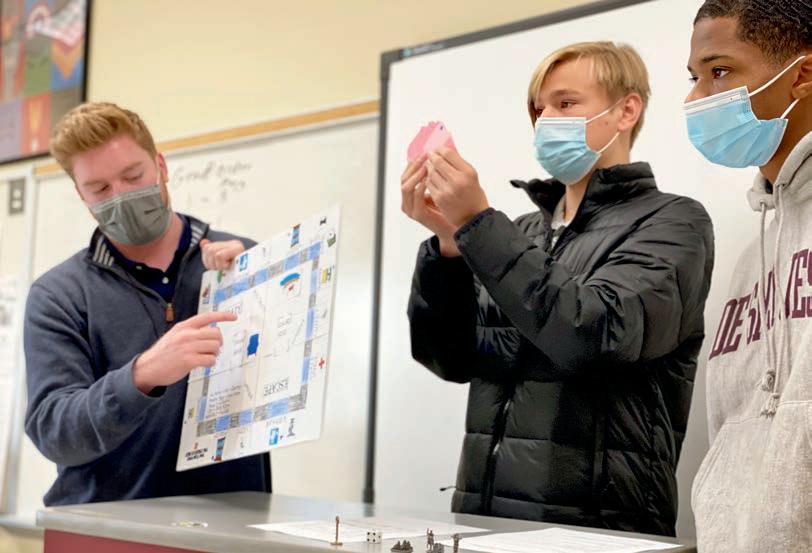
Above: “There’s a 20-minute time limit, then the fog comes in fully crazy,” said Bennett Mueller ‘22 (at center) with Will Teepe ‘22 (at left) and Devin Jones-Ransom ‘22 as they demonstrated their handmade board game for Best Novels senior English class.
Right: (from left) Harris King ‘22 and Gabe Lasek ’22 identify areas on the redlined map of St. Louis made by Bailey Mathews ‘22 for AP English.
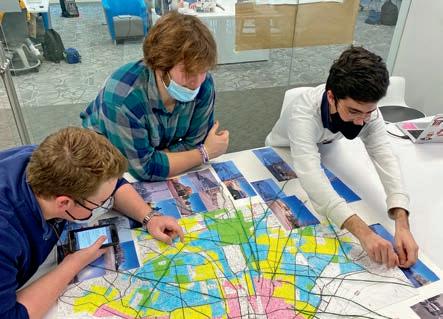
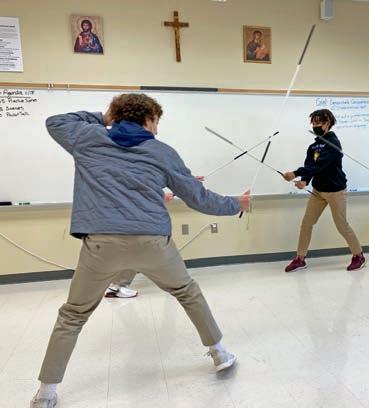

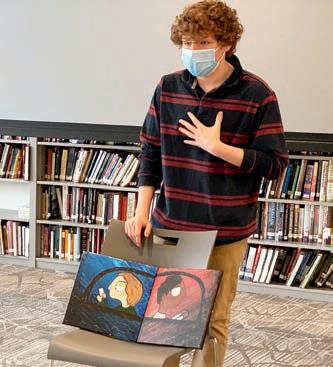
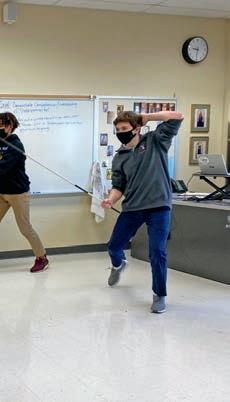
“We’re imitating Star Wars sword fights
to practice for Romeo and Juliet,” explained Michael Sullivan ’25, as his group translated Shakespeare’s iambic pentameter into modern speak on a shared Word document. Deconstructing the classic script into how we would say it today — and acting out both versions for classmates — helps students train their brains to comprehend harder material at a higher level, said Mr. Samson. “You can be silly with it,” he told the boys, “but don’t let the silliness overrule the accuracy of what you’re doing.”
— FRESHMAN HONORS ENGLISH 1 (top left)
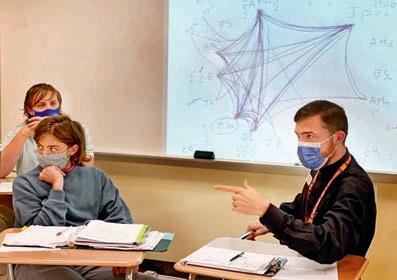
“I was afraid when I got pulled over,” said Alex Lewis ’22 (at left), “but not afraid like my black friends are.” Alex stood behind his original paintings that depicted two teens driving as part of his AP English final. In the Innovation Center, classmates presented in a museum format to share their semester-long research on diverse social justice issues and student-selected topics ranging from immigration to veterans’ suffering, and much more. Tapping into their creativity, students completed the multimodal project requirement via podcasts, Pokémon-inspired presentations, online news articles, letters to Missouri’s legislator, and Prezi videos.
— SENIOR AP ENGLISH 4, SLU 1818 CREDIT (left, and bottom left)
“Everyone starts off with two candy cigarettes,” said Ethan Selkirk ’22, demonstrating his group’s custom designed board game for One Flew Over the Cuckoo’s Nest, complete with a Nurse’s Station and a Shock Shop space. After reading The Godfather and playing The Don board game, seniors asked Mr. Bergman if the Ken Kesey novel also had a corresponding game. “I told them no; then realized we can make our own,” he said. “They’re grading themselves, having fun, and channeling some character personality.” With creative player strategies and enhancements such as Fog Space and the Chain Smoker Card, designing the games, “… shows we understood the novel and read it,” said Chris Beason ’22. “The Pine Cone of Life” was one of many titles submitted for the Ralph Waldo Emerson-inspired assignment where Mr. Cavanagh escorted his juniors outside to find an image in nature they connected with to better understand transcendentalism. Students explored near trees, walked around chapel grounds, or ran to the wooded path (to search for pine cones). They took pictures with their phones, emailed themselves the photos, then headed back to the classroom to use No Red Ink software to write a short essay — pithy title encouraged. “The natural world teaches us lessons for living,” said Mr. Cavanagh. “It can teach us about who we are.”
— JUNIOR ENGLISH 3 (center)
“There’s a star on my name!” proclaimed Aiden McIlwaine ’24 after a spider web diagram was projected on the board. “Star meant you made a really important comment,” explained Mr. Manaker, S.J., who had just spent 30 minutes tracking the entirely student-led class conversation about Homer’s The Odyssey. He used abbreviation codes to note distractions, vocabulary use, textual connections, and even one student’s identification of an epic simile at the 24-minute mark. Each time someone spoke, Mr. Manaker drew a line to the student’s name, resulting in a data-rich web diagram that he can use to understand class conversation patterns, individual participation levels, and student engagement.
— SOPHOMORE HONORS ENGLISH 2 (left)
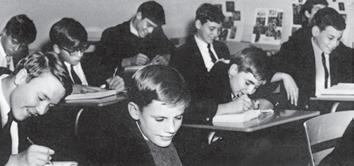
DE SMET JESUIT ARCHIVES
NOWTHEN&
Before essays were typed on laptops and novels could be downloaded as PDFs, the earliest students at De Smet Jesuit carried their books to grade-level English (no electives to speak of). Freshmen in 1967 read Ray Bradbury’s The Martian Chronicles (1950) and as seniors in 1970-1971, they were assigned Bernard Malamud’s The Natural (1952), 32 years before Robert Redford would play Roy Hobbs in the movie.
“I enjoyed that novel so much, that may have been an inkling of what I wanted to do,” said Richard Johnson ’71, who later pursued his masters and doctorate in literature, then became an English profesor at St. Charles Community College for 27 years.
“I don’t remember the use of any technology,” said Dr. Johnson of his high school days. “I would write essays in a very neat hand on loose leaf.” Another difference? “There seems to be a greater emphasis on rhetoric in connection with various literary works. There wasn’t that emphasis when in I was in high school.”
As for what has stayed the same? Grammar. “Grammar’s everything,” noted Dr. Johnson. That, and he adds, “basically just reading the text. I think students should be challenged in what they read. They shouldn’t be given the easy stuff.”




